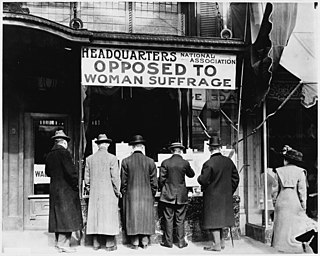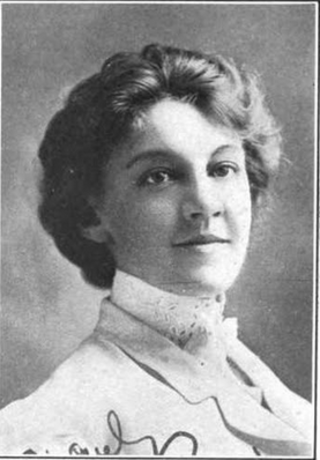
January 20, 1907

March 1907
Bettina Borrmann Wells (born 1874) was a Bavarian-born English suffragette who toured the United States as an organizer and lecturer. (She rejected the term "suffragist" for her work, preferring "suffragette".)


Bettina Borrmann Wells (born 1874) was a Bavarian-born English suffragette who toured the United States as an organizer and lecturer. (She rejected the term "suffragist" for her work, preferring "suffragette".)
Bettina Borrmann was born in Nuremberg, Bavaria, and was a graduate of the University of Geneva. [1] In 1914, 1915, and 1916 she earned bachelor's and master's degrees in economics and psychology at Columbia University. [2] [3] Her master's thesis was titled "The economic basis of the present feminist movement" (1915). [4]
Bettina Borrmann Wells was a member of the Women's Social and Political Union. [5] In November 1908, Bettina Borrmann Wells served a three-week sentence in Holloway Prison, [6] for "obstructing a policeman" at a demonstration in London. [7] She called herself a "suffragette", explaining that "a suffragette is a suffragist who is willing to die for the cause." [8] By 1910 Wells had moved away from Emmeline Pankhurst's arm of the movement [9] and she was very active in the Manchester wing of the Women's Freedom League. [10] In 1911 an American newspaper described her as head of the propaganda department of the "Women's Federation League" of England. [11]
In the United States in 1908, Wells, Maud Malone, Christine Ross Barker, Sophia Loebinger, and others organized open-air meetings of the Progressive Woman Suffrage Union in New York City's Madison Square, Wall Street, Harlem, and Brooklyn, [12] [13] against significant resistance from the city's residents and business leaders. [14] [15] [16] In spring 1908, Wells and Malone led a suffrage parade in New York City, without a permit. [17] Later that year, Wells and three other suffragists attempted to meet with Theodore Roosevelt in Oyster Bay, New York, but they were rebuffed by the Secret Service. [18]
She toured the United States and Canada [19] with her husband, meeting with suffrage activists in various cities. [20] "Women will only get the vote when they make men believe they are serious and will pay the price for it," she told an audience in Brooklyn, "They won't get it by arranging for pink teas and yellow bazars." [21] In 1909 she published a pamphlet, America and Woman Suffrage, detailing suffrage activities in Wyoming, Utah, Colorado, and Idaho. [22]
Wells also wrote pro-suffrage letters to the editor, both in Great Britain [23] and in the United States. [24] "I admit that 'better laws have passed without any vote of woman'," she conceded in one 1908 letter to the New York Times. "One can also get to California on foot, but most of us prefer speedier methods of traveling." [25]
Wells traveled to Washington, D.C. in January 1917, to take a turn as one of the "Silent Sentinels" picketing the White House, in the early weeks of that protest. [26] [27]
Bettina Borrmann married English businessman Herbert James Clement Wells in 1900. She was a member of the Lyceum Club of London, and of the Society of Women Journalists of London. [28]

The Women's Social and Political Union (WSPU) was a women-only political movement and leading militant organisation campaigning for women's suffrage in the United Kingdom from 1903 to 1918. Known from 1906 as the suffragettes, its membership and policies were tightly controlled by Emmeline Pankhurst and her daughters Christabel and Sylvia; Sylvia was eventually expelled.

The United Procession of Women, or Mud March as it became known, was a peaceful demonstration in London on 9 February 1907 organised by the National Union of Women's Suffrage Societies (NUWSS) in which more than 3,000 women marched from Hyde Park Corner to the Strand in support of women's suffrage. Women from all classes participated in what was the largest public demonstration supporting women's suffrage seen until then. It acquired the name "Mud March" from the day's weather since incessant heavy rain left the marchers drenched and mud-spattered.

Marion Wallace Dunlop was a Scottish artist and author. She was the first and one of the most well known British suffragettes to go on hunger strike, on 5 July 1909, after being arrested in July 1909 for militancy. She said she would not take any food unless she was treated as a political prisoner instead of as a common criminal. Wallace Dunlop's mode of protest influenced suffragettes after her and other leaders like M. K. Gandhi and James Connolly, who also used fasting to protest British rule. She was at the centre of the Women's Social and Political Union and designed processions and banners for them.

Anti-suffragism was a political movement composed of both men and women that began in the late 19th century in order to campaign against women's suffrage in countries such as Australia, Canada, Ireland, the United Kingdom and the United States. To some extent, Anti-suffragism was a Classical Conservative movement that sought to keep the status quo for women. More American women organized against their own right to vote than in favor of it, until 1916. Anti-suffragism was associated with "domestic feminism," the belief that women had the right to complete freedom within the home. In the United States, these activists were often referred to as "remonstrants" or "antis."

A suffragette was a member of an activist women's organisation in the early 20th century who, under the banner "Votes for Women", fought for the right to vote in public elections in the United Kingdom. The term refers in particular to members of the British Women's Social and Political Union (WSPU), a women-only movement founded in 1903 by Emmeline Pankhurst, which engaged in direct action and civil disobedience. In 1906, a reporter writing in the Daily Mail coined the term suffragette for the WSPU, derived from suffragist, in order to belittle the women advocating women's suffrage. The militants embraced the new name, even adopting it for use as the title of the newspaper published by the WSPU.

Una Harriet Ella Stratford Duval was a British suffragette and marriage reformer. Her refusal to say "and obey" in her marriage vows made national news.

Maud Malone, also seen as Maude Malone, was an American librarian and "militant suffragette" based in New York. She was also a spokesperson for the Library Employees' Union, the first labor union for public library workers in the United States.

The National Association Opposed to Women Suffrage (NAOWS) was founded in the United States by women opposed to the suffrage movement in 1911. It was the most popular anti-suffrage organization in northeastern cities. NAOWS had influential local chapters in many states, including Texas and Virginia.

Zelie Passavant Emerson was an American suffragette in England. She suggested and then founded the Workers' Dreadnought newspaper with Sylvia Pankhurst, and she was injured by London police in a suffrage riot in 1913.

Lucy Minnie Baldock was a British suffragette. Along with Annie Kenney, she co-founded the first branch in London of the Women's Social and Political Union.

Gladice Georgina Keevil was a British suffragette who served as head of the Midlands office of the Women's Social and Political Union between 1908 and 1910.

Helen Tolson (1888–1955) was an English suffragette from Wilmslow in Cheshire active in the Women's Social and Political Union (WPSU). She was repeatedly arrested in 1908 and 1909.
Caroline Phillips was a Scottish feminist, suffragette and journalist. She was honorary secretary of the Aberdeen branch of the Women's Social and Political Union (WSPU), met and corresponded with many of the leaders of the movement and was also involved in the organisation of militant action in Aberdeen.

Amy Ricard was an American actress and suffragist.

Edith Hudson was a British nurse and suffragette. She was an active member of the Edinburgh branch of the Women's Social and Political Union (WSPU) and was arrested several times for her part in their protests in Scotland and London. She engaged in hunger strikes while in prison and was forcibly fed. She was released after the last of these strikes under the so-called Cat and Mouse Act. Hudson was awarded a Hunger Strike Medal 'for Valour' by the WSPU.

Women's suffrage, the legal right of women to vote, has been depicted in film in a variety of ways since the invention of narrative film in the late nineteenth century. Some early films satirized and mocked suffragists and Suffragettes as "unwomanly" "man-haters," or sensationalized documentary footage. Suffragists countered these depictions by releasing narrative films and newsreels that argued for their cause. After women won the vote in countries with a national cinema, women's suffrage became a historical event depicted in both fiction and nonfiction films.

Katherine Douglas Smith was a militant British suffragette and from 1908 a paid organiser of the Women's Social and Political Union (WSPU). She was also a member of the International Suffrage Club.
"The Women's Marseillaise" was the former Women's Social and Political Union (WSPU) official anthem. It was sung to the tune of La Marseillaise and included words about women's suffrage written by Florence MacAulay. The song was sung by suffragists in both the United Kingdom and the United States.

Sophia Monté Neuberger Loebinger (1865–1943) was a Jewish-American singer, philanthropist, women's suffrage activist, orator, writer, and newspaper editor. While often remembered as a suffragist, her brand of pro-suffrage activism adopted both the namesake and political outlook of the British-derived suffragette movement. Like her British predecessors, Loebinger's activism employed more radical and militant tactics than the adjacent American suffragists. Such radicalism made waves in the media both locally and nationally, and helped galvanize a public politics of protest for the American suffrage movement. She was a founding member of the Progressive Woman Suffrage Union and served as both editor and a regular contributor to its newspaper, The American Suffragette.